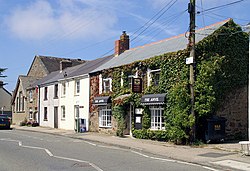Cubert
| Cubert Cornish: Lannowynn | |
| Cornwall | |
|---|---|
 Cottages and pub of Cubert | |
| Location | |
| Grid reference: | SW785579 |
| Location: | 50°22’44"N, 5°7’1"W |
| Data | |
| Population: | 1,155 (2001) |
| Post town: | Newquay |
| Postcode: | TR8 |
| Dialling code: | 01637 |
| Local Government | |
| Council: | Cornwall |
| Parliamentary constituency: |
Truro and Falmouth |
Cubert is a village in Cornwall found three miles south-southwest of Newquay.
Once known as St Cubert, the village is dominated by the spire of its 14th century church which was enlarged by the addition of a south aisle a century later.
The village is named after the Welsh missionary St Cubert who, as a companion of St Carantoc, brought the Christian faith to this part of Cornwall, and to whom the church is dedicated. Unlike his companion St Carantoc, who travelled on to Brittany, St Cubert returned to Wales becoming abbot of his monastery and, according to the Welsh chronicles, dying in 775.
The hamlets of Tresean, Trevail, Trevemper and Trevowah are in the parish.[1]
History and antiquities
The village was formerly "St Cubert" but lost its prefix at the Reformation, as the churchwardens whitewashed over the "superstitious pictures" on the church walls, including a figure of Cubert dressed as an abbot. On early maps it often appears as St Kibberd, possibly indicating a local pronunciation.
To the west of the village, half way between the village and the coast, is the mediæval Holy Well dedicated to St Cubert, from which the coastal bay takes its name. At the north end of the beach, only accessible two hours before and after low-tide, is a natural well in the rock that 19th century romanticists like to think was the origin of the name Holywell.
A mile to the east of the village near the Newquay crossroads, where the four parishes of St Cubert, Crantock, St Newlyn East and Perranzabuloe meet, was the chapel of St Nectan (the foundations of which were uncovered when the road was widened and straightened in 1970), where on certain feasts during the year the relics of the Patron Saints of the four parishes were carried in procession for their veneration by the faithful.
An inscribed stone, dated from the sixth to eighth centuries, was found imbedded in the walls of the fifteenth-century church. It bears the name of "Cenet[o]cus, son of Tege[r]nomalus".[2]
Pictures
Outside links
| ("Wikimedia Commons" has material about Cubert) |



